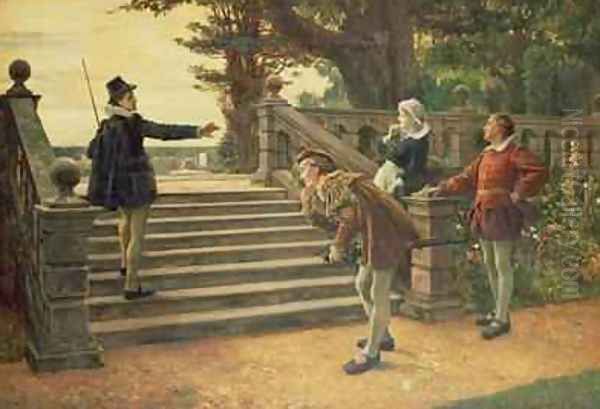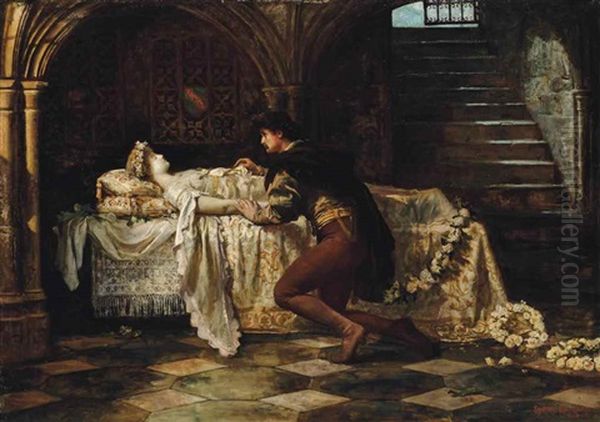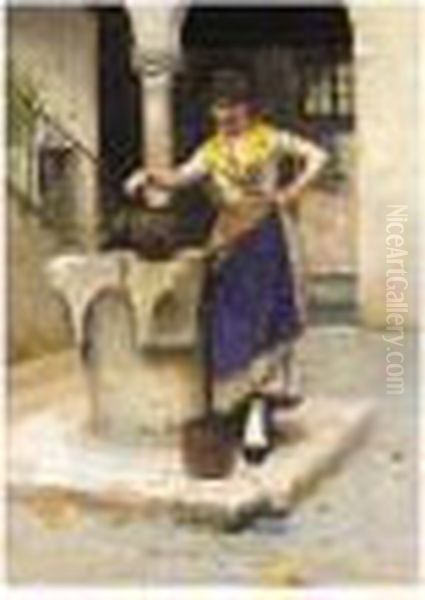Francis Sydney Muschamp stands as a notable figure within the landscape of late 19th-century British art. Active during a period rich with artistic exploration and revivalism, Muschamp carved a niche for himself as a painter drawn to the narratives and aesthetics of the past. Born in 1851 and passing away in 1929, his career spanned a significant era of change, yet his artistic focus remained largely consistent, favouring themes drawn from literature, history, and mythology, rendered in a style deeply indebted to the prevailing Neo-Classical sensibilities of his time.
As an artist working in Victorian Britain, Muschamp operated within a vibrant and often competitive art world. He is frequently discussed in relation to the giants of the era's classical revival, particularly Frederic, Lord Leighton and Sir Lawrence Alma-Tadema. While perhaps not achieving the same level of widespread fame as these contemporaries, Muschamp's work shares their meticulous attention to detail, polished finish, and fascination with historical settings, positioning him as a significant contributor to this popular strand of academic painting. His dedication to crafting evocative scenes from bygone eras earned him recognition and a steady presence in the exhibition halls of London and beyond.
Early Life and Artistic Beginnings
Francis Sydney Muschamp entered the world in Hull, a city in the East Riding of Yorkshire, England, in 1851. His artistic inclinations may have been fostered early on, as he was the son of Francis Muschamp, himself a landscape painter. This familial connection to the art world likely provided an environment conducive to developing his own talents. While specific details regarding his formal art education or early training remain scarce in historical records, his trajectory suggests a path familiar to many aspiring artists of the time.

The family eventually relocated to London, the epicentre of the British art scene. By 1865, the Muschamps were residing at 58 College Place in Camden Town. It was in this year, at the young age of about fourteen, that Francis Sydney Muschamp achieved his first significant public exposure. He began exhibiting his work with the Royal Society of British Artists (RBA) in Suffolk Street, an important venue for established and emerging artists alike. This early debut marked the beginning of a long and productive career dedicated to the visual arts.
Artistic Style and Dominant Influences
Muschamp's artistic identity is firmly rooted in the Neo-Classical movement as it manifested in 19th-century Britain. This style, looking back to the art of Ancient Greece and Rome, as well as Renaissance and Baroque masters, emphasized order, clarity, idealized forms, and often drew upon historical or mythological subject matter. Muschamp embraced these tenets, creating works characterized by careful composition, smooth brushwork, and a high degree of finish.
His style inevitably invites comparison with the leading academic painters of the day. The influence of Lord Leighton, President of the Royal Academy, can be seen in the idealized figures and harmonious compositions found in some of Muschamp's works. Even more pronounced, perhaps, is the connection to Sir Lawrence Alma-Tadema, renowned for his archaeologically informed depictions of daily life in antiquity. Muschamp shared Alma-Tadema's penchant for rendering textures – marble, fabrics, flowers – with convincing realism, and for placing his historical narratives within meticulously detailed settings.
While Leighton and Alma-Tadema are the most frequently cited comparisons, Muschamp's work also resonates with other contemporaries exploring similar themes. Artists like Edward Poynter, another prominent classicist, or Albert Moore, known for his aesthetic arrangements of figures in classical drapery, were part of the same artistic milieu. Muschamp navigated this landscape, developing his own variations on classical and historical themes, often infusing them with a distinctly Victorian sensibility for narrative and sentiment.
Themes and Subject Matter
A defining characteristic of Francis Sydney Muschamp's oeuvre is his consistent engagement with specific thematic areas. His imagination was captured by the stories, aesthetics, and perceived romance of earlier times, which he translated into compelling visual narratives on canvas.
Shakespearean Visions
Literature, particularly the works of William Shakespeare, provided a rich source of inspiration for Muschamp. The Victorian era saw a resurgence of interest in Shakespeare, and his plays offered dramatic scenarios, complex characters, and historical settings that appealed to narrative painters. Muschamp contributed to this trend with several works based on the Bard's plays.

Among his documented Shakespearean subjects are paintings inspired by The Merchant of Venice, Twelfth Night (specifically The Fool and Maria), and most notably, Romeo and Juliet. His depiction of Romeo and Juliet is said to capture the poignant scene of Juliet discovered apparently lifeless after taking the Friar's potion, a moment of high drama and pathos. He also painted Juliet and her Nurse, focusing on the relationship between the young heroine and her confidante. These works demonstrate Muschamp's ability to interpret iconic literary moments, translating the emotional weight of the text into visual form. This interest aligns him with other Victorian artists who tackled Shakespeare, such as John Everett Millais in his famous Ophelia.
Echoes of Antiquity
Following the Neo-Classical tradition, Muschamp frequently turned his attention to the world of ancient Greece and Rome. Mythological tales and scenes inspired by classical life appear in his work, reflecting the era's fascination with antiquity as a source of beauty, heroism, and moral exemplars.
One specific example mentioned is The Winning of the Golden Fleece, a subject drawn from the Greek myth of Jason and the Argonauts. This theme allowed for the depiction of heroic figures, dramatic action, and potentially exotic settings, all staples of classically inspired art. His approach to these subjects likely involved careful attention to classical costume, architecture, and idealized human forms, echoing the work of contemporaries like George Frederic Watts or Leighton, who also frequently explored mythological narratives.
Moments in Time: Genre and History
Beyond specific literary or mythological tales, Muschamp excelled at creating evocative scenes depicting life in various historical periods, particularly the Elizabethan and Baroque eras. These paintings often blend historical settings with elements of genre painting, focusing on intimate moments, social interactions, or romantic encounters.
Works like The Flirtatious Gentlemen! (also cited as The Charming Gentlemen!) suggest a focus on social dynamics and perhaps light-hearted romantic intrigue within a historical context. The Love Letter, described as depicting elegantly dressed women reading a letter in a well-appointed interior, falls into this category, offering a glimpse into the private lives of the affluent past. His painting Queen May, dated 1889, likely portrays a scene related to May Day festivities, possibly with a historical or allegorical dimension. These genre and historical scenes allowed Muschamp to showcase his skill in rendering period costumes, detailed interiors, and expressive figures, similar in spirit, if not always in scale, to the historical crowd scenes of William Powell Frith, though Muschamp's focus seems more intimate.
Beyond the Narrative: Landscapes and Other Subjects
While primarily known for his narrative works, Muschamp did not confine himself exclusively to historical or literary themes. Evidence suggests he also engaged with other genres. His father was a landscape painter, and Francis Sydney himself produced some landscape works, such as At Burnham Beeches, exhibited in 1877. This indicates an engagement with the natural world, a popular subject in British art.

He also painted scenes involving children, such as Children on the Beach. This subject, often imbued with sentimentality in the Victorian era, shows another facet of his artistic interests. These works, though perhaps less central to his reputation than his grander narrative pieces, demonstrate a degree of versatility in his output.
Career, Exhibitions, and Recognition
Francis Sydney Muschamp pursued a consistent and visible career within the London art establishment. Following his debut at the Royal Society of British Artists (RBA) in 1865, he continued to exhibit regularly at major venues throughout his working life. His participation in these exhibitions was crucial for building his reputation and securing patronage.
He was a frequent exhibitor at the RBA, eventually becoming a member of the society, a mark of peer recognition. Records show him exhibiting there as late as 1903. His work also graced the prestigious walls of the Royal Academy of Arts in London, the pinnacle of the British art world. Exhibiting at the RA signified a high level of professional achievement.
Muschamp's reach extended beyond the capital. His paintings were shown at important regional institutions, including the Royal Birmingham Society of Artists and the Manchester City Art Gallery. He also exhibited at the Dudley Gallery in London. This consistent presence across multiple respected venues underscores his standing as a recognized professional artist of his time. His works, like The Flirtatious Gentlemen!, were seen by a wide public through these exhibitions.
A Closer Look at Notable Works
While many of Muschamp's paintings are known primarily through titles or brief descriptions, some offer glimpses into his specific artistic choices.
Romeo and Juliet: As mentioned, this work tackled a key moment from Shakespeare's tragedy. The description suggests a focus on the dramatic discovery of Juliet, presumably in her death-like sleep. The mention of "blue tones" in some descriptions might refer to the overall colour palette used to evoke a sense of coldness, night, or sorrow, enhancing the scene's emotional impact. Such choices highlight Muschamp's use of colour not just for description but for mood.
Queen May (1889): This oil on canvas painting, dated specifically to 1889, likely depicts a figure or scene associated with traditional May Day celebrations, perhaps featuring a 'May Queen' adorned with flowers. Such subjects allowed artists to explore themes of youth, spring, tradition, and beauty, often set against a backdrop of idealized nature or historical revelry. The date places it firmly within his mature period.
The Love Letter: This painting exemplifies Muschamp's engagement with historical genre scenes. The description emphasizes the elegant attire of the female figures and the richness of their surroundings, suggesting a focus on material detail and social status. The act of reading a love letter introduces a narrative element of romance and private emotion, a popular theme in Victorian art. It showcases his ability to create intimate, aesthetically pleasing scenes drawn from an imagined past.
The Flirtatious Gentlemen!: The title itself suggests a narrative focused on social interaction and courtship, likely set in a historical period suggested by costume and setting. This work, exhibited at prominent venues like the Royal Academy, would have appealed to Victorian tastes for storytelling and depictions of manners and romance from bygone eras.
Context, Comparisons, and Contemporaries
To fully appreciate Francis Sydney Muschamp's contribution, it is essential to view him within the broader context of Victorian art. His Neo-Classical style placed him alongside, and often in comparison with, the era's most celebrated academic painters, Leighton and Alma-Tadema. He shared their commitment to technical skill, historical detail, and idealized beauty.
However, the Victorian art scene was diverse. While Muschamp adhered to classical principles, other movements flourished concurrently. The Pre-Raphaelite Brotherhood, initially represented by artists like Dante Gabriel Rossetti, John Everett Millais, and William Holman Hunt, also emphasized narrative and detail but often drew inspiration from medieval sources and employed a brighter palette and different compositional strategies.
Later artists associated with classical themes, sometimes termed the "Olympians," included figures like Herbert Draper and John Collier, who continued to paint mythological and historical subjects into the early 20th century, often with a more sensuous or dramatic flair than seen in Muschamp's typically more restrained compositions. Muschamp's work represents a specific, popular, and enduring strand of Victorian classicism, focused on narrative clarity and refined execution. His chosen themes – Shakespeare, classical myth, historical genre – were widely popular among patrons and the public during his lifetime.
Clarifications and Attributions
When researching Francis Sydney Muschamp, some potential points of confusion arise. It's important to distinguish him from other individuals named Muschamp who appear in historical records. For instance, references exist to a Geoffrey de Muschamp, a historical figure connected with church affairs centuries earlier, and a Denny Muschamp involved in legal and land matters in Ireland. These individuals have no direct connection to the artist.
More relevant is the potential confusion with Herbert Muschamp (1947-2007), a prominent American architecture critic. Some sources erroneously attribute publications on architecture, such as Masters of Architecture (cited with a 1990 publication date), to Francis Sydney Muschamp. Given the subject matter and date, this attribution is almost certainly incorrect and belongs to the later critic, not the 19th-century painter. Francis Sydney Muschamp's own documented publications seem limited, though one source mentions a book titled Romeo and Juliet attributed to him, the nature of which (an illustrated edition? a commentary?) remains unclear from the provided context.
Furthermore, the available information, while detailing his exhibition history and thematic concerns, does not specify who his direct teachers were, nor does it name any students or close collaborators. His primary influences appear to be the leading academic painters of his day and the broader Neo-Classical tradition.
Legacy and Art Historical Assessment
Francis Sydney Muschamp's legacy resides primarily in his body of work, which exemplifies a significant aspect of late Victorian artistic taste. He is evaluated by art history as a skilled and accomplished painter working within the Neo-Classical and historical genre traditions. His strengths lay in his meticulous technique, his ability to construct convincing historical settings, and his talent for narrative clarity.
His frequent comparisons to Lord Leighton and Sir Lawrence Alma-Tadema position him as a recognized practitioner within their circle, even if he did not achieve their level of overarching influence or innovation. He successfully catered to the Victorian appetite for beautifully rendered scenes drawn from literature, mythology, and history, often imbued with sentiment and romance. His consistent exhibition record at major institutions attests to the respect he commanded during his lifetime.
While Muschamp may not be credited with significantly altering the course of art history or founding a new school of painting, his work remains a valuable representation of the academic tradition in late 19th-century Britain. His paintings continue to appear at auction, such as the mention of Queen May in a Beijing Rongbao auction preview, indicating ongoing interest among collectors. His contribution lies in his skillful interpretation of popular historical and literary themes, executed with the polished technique characteristic of the era's academic masters.
Conclusion
Francis Sydney Muschamp navigated the complexities of the Victorian art world with considerable success. From his early beginnings, possibly influenced by his landscape painter father, he developed into a proficient artist specializing in Neo-Classical and historical subjects. His dedication to themes drawn from Shakespeare, classical antiquity, and romanticized visions of the past resonated with the tastes of his time.
Compared favourably with luminaries like Leighton and Alma-Tadema, and exhibiting alongside many other prominent artists of the day, Muschamp established himself as a respected member of the British art community, recognized through his membership in the RBA and his presence at the Royal Academy and major regional galleries. Though perhaps overshadowed in the annals of art history by more revolutionary figures, his work endures as a fine example of Victorian narrative painting, appreciated for its technical skill, evocative settings, and engagement with the enduring stories and aesthetics of Western culture. His paintings offer a window into the artistic sensibilities of an era captivated by history, literature, and idealized beauty.